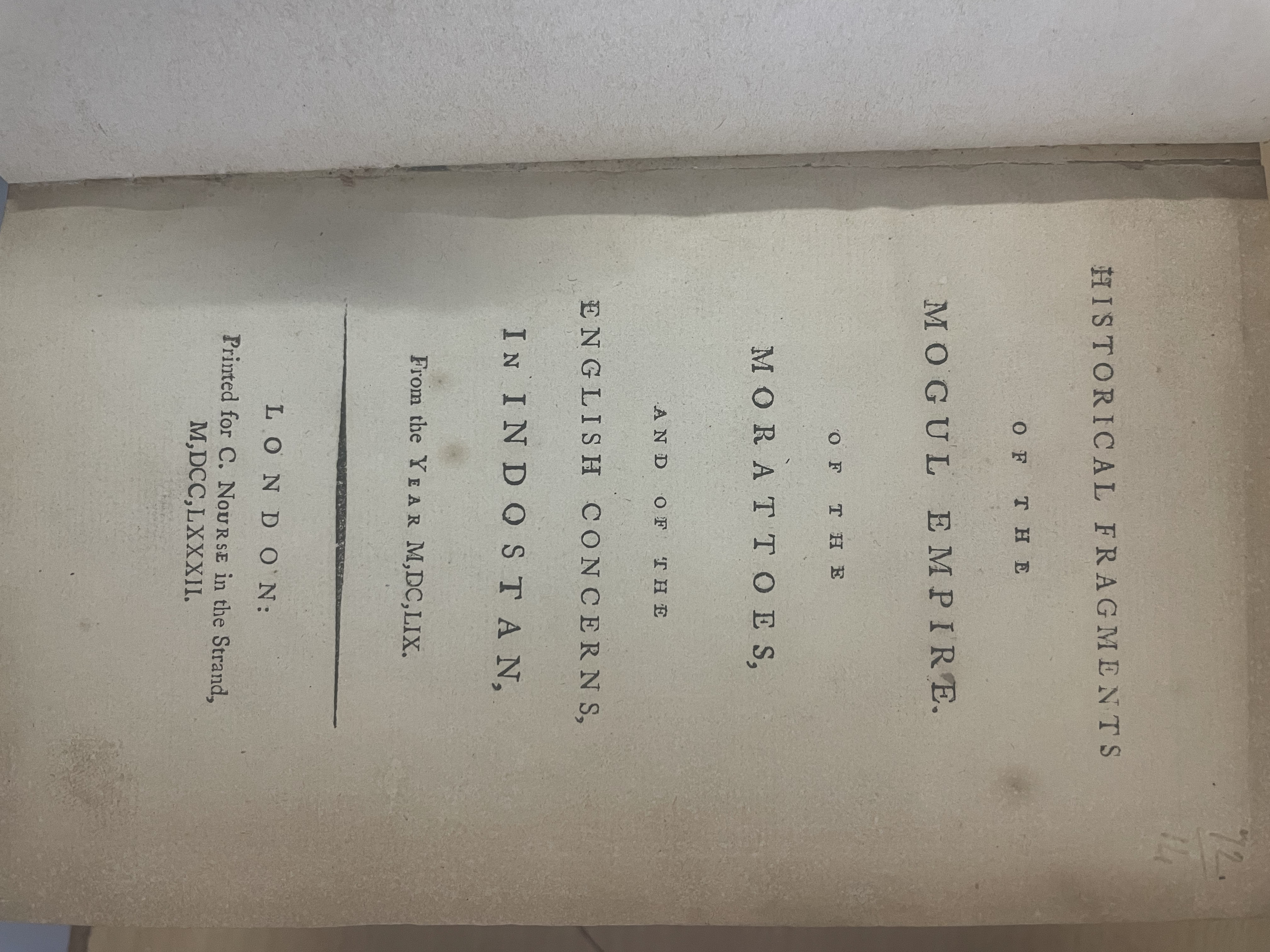Historical Fragments of the Mogul Empire of the Morattoes

About
Summary
Exquisite
TOC
Details
Related
URL
Images
Overview
Historical Fragments of the Mogul Empire of the Morattoes by Robert Orme is a significant historical work that chronicles the complex interactions between the Mughal Empire, the Maratha Confederacy, and the British East India Company during the late 17th and early 18th centuries. This book provides a detailed account of the political, military, and social dynamics that shaped India during a transformative period.The book is structured as a chronological narrative that covers key events and developments in the Mughal Empire and its interactions with the Marathas and British interests. Orme draws from various sources and his own observations to provide a comprehensive view of this historical period.
Historical Context: Orme begins by setting the stage for understanding the political landscape of India in the late 17th century. He discusses the decline of Mughal power following the death of Emperor Aurangzeb in 1707 and how this vacuum allowed other powers, particularly the Marathas, to rise.
The Rise of the Marathas: A significant portion of the book focuses on the emergence of the Maratha Confederacy under leaders like Shivaji and later figures such as Balaji Vishwanath. Orme details their military campaigns against Mughal forces and their strategies for consolidating power in western India.
British Interests: The narrative also examines how British traders and officials navigated this turbulent political landscape. Orme discusses key events that led to increased British involvement in Indian affairs, including alliances with local rulers and military engagements against both Mughal and Maratha forces.
Military Conflicts: The book provides detailed accounts of various military conflicts, including battles between Mughal armies and Maratha forces. Orme analyzes tactics used by both sides and reflects on how these conflicts influenced broader political dynamics in India.
Cultural Observations: Throughout his account, Orme offers insights into the cultural practices of both Mughals and Marathas, including governance styles, social hierarchies, and religious practices. He reflects on how these cultural elements impacted political relationships.
Importance of Book
Historical Documentation: The book serves as an important historical record that documents key events in Indian history during a time of significant change. It provides valuable insights into the political landscape following Aurangzeb's reign.
Understanding Colonialism: Orme’s work helps readers understand how colonial powers began to engage with local politics in India. It sheds light on early British strategies for establishing control over Indian territories.
Influence on Scholarship: The book has influenced subsequent historians studying Indian history by providing foundational narratives that have been referenced in later research on Mughal decline, Maratha expansion, and British colonialism.
Cultural Exchange: By documenting interactions among different cultures in India, Orme’s work contributes to a broader understanding of cultural exchange during a period marked by conflict and negotiation.
Key Themes
Power Dynamics: A central theme in Orme’s work is the shifting power dynamics between the Mughal Empire, Maratha Confederacy, and British East India Company. The narrative illustrates how power was contested through military engagements, diplomacy, and strategic alliances.
Colonial Expansion: The book highlights the early stages of British colonial expansion in India. It reflects on how British interests began to shape local politics and economies amid declining Mughal authority.
Cultural Interactions: Orme emphasizes cultural interactions between different groups in India. He discusses how trade, warfare, and diplomacy facilitated exchanges between Mughals, Marathas, and Europeans.
Religious Tensions: The narrative touches upon religious tensions within Indian society, particularly between Hindus and Muslims during conflicts involving both Mughals and Marathas. These tensions often influenced political allegiances.
Cultural Significance
Literary Contribution: As an early example of historical writing about India from a European perspective, it contributes to travel literature by providing insights into life during a critical period in Indian history.
Foundation for Historical Studies: The book lays groundwork for future studies on colonialism by documenting interactions between different civilizations while also reflecting on power dynamics at play during this period.
Intercultural Dialogue: By presenting multiple viewpoints on cultures around the world, it fosters dialogue about tolerance, understanding, and appreciation for diversity among readers.
Reflection on Imperial Attitudes: The narratives reflect imperial attitudes prevalent during their times while also offering critiques that can lead to discussions about imperialism's legacy today.
Effects on Society
Shaping European Perspectives: The book played a crucial role in shaping European views about India during a time when many were unaware of its rich history and cultural diversity.
Stimulating Interest in Indian History: Orme’s detailed descriptions sparked interest among Europeans regarding Indian culture and history, leading to increased scholarly pursuits in understanding Indian society.
Influencing Colonial Policies: The insights provided by Orme influenced colonial policies as European powers sought to establish their presence in India based on economic interests highlighted in his commentary.
Cultural Reflection: The book encouraged readers in Europe to reflect on their own beliefs concerning those they encountered abroad, fostering curiosity about different worldviews.
Legacy in Historical Scholarship: As late as the 19th century, scholars referenced Orme’s observations as some of the most complete accounts available regarding Mughal history during its decline.
Conclusion
Historical Fragments of the Mogul Empire of the Morattoes by Robert Orme stands as a critical historical document that offers profound insights into 18th-century perceptions of power dynamics within India from a European perspective. Its detailed exploration of military engagements provides valuable historical context for understanding early intercultural exchanges between Europe and Asia.
The importance of this work lies not only in its content but also in its role as a precursor to modern historical scholarship that emphasizes direct observation and engagement with diverse cultures. It highlights early efforts at understanding complex belief systems while reflecting broader themes of curiosity and respect for cultural differences.
Title
Historical Fragments of the Mogul Empire of the Morattoes
Author
Robert Orme
Name of Publisher
Printed for C Nourse in the Strand
Subject
Overview of the Mogul Empire and Morattoes (Marathas)
Vintage
1701-1800
Category
History
Sub Category
Biography
Rarity
RARE
